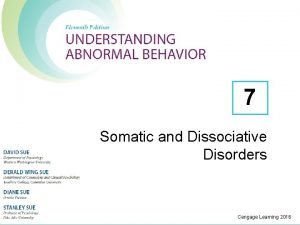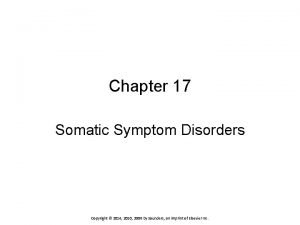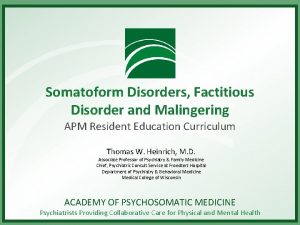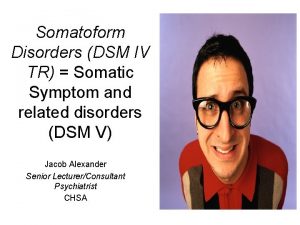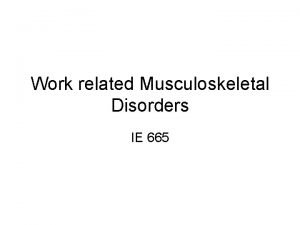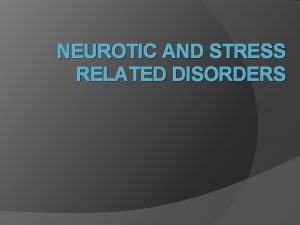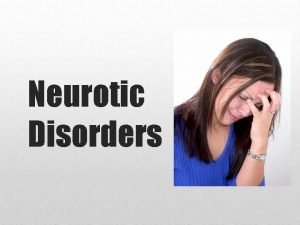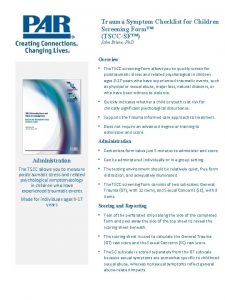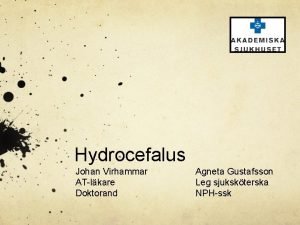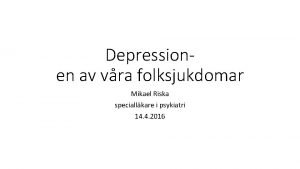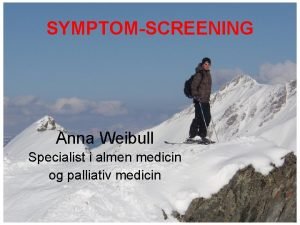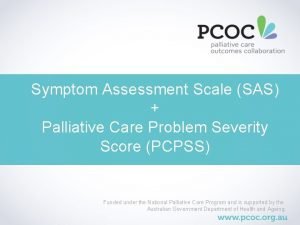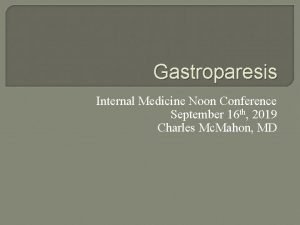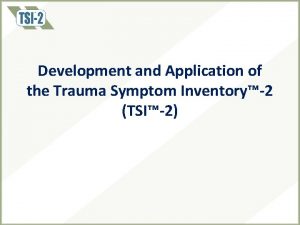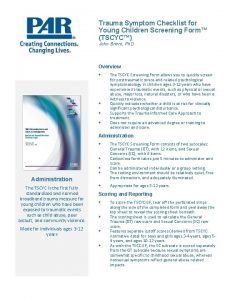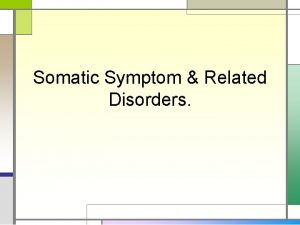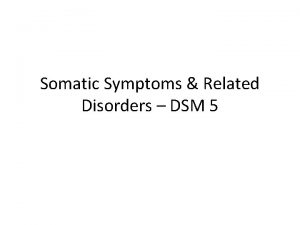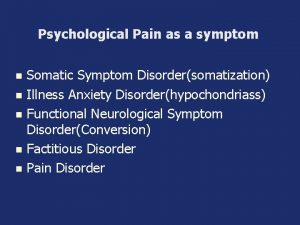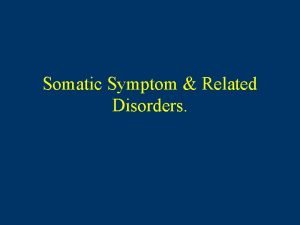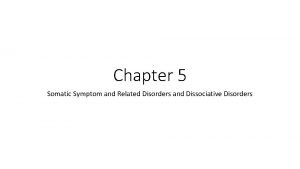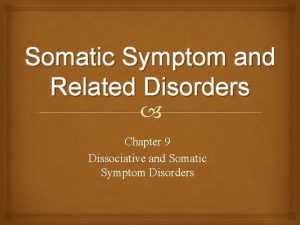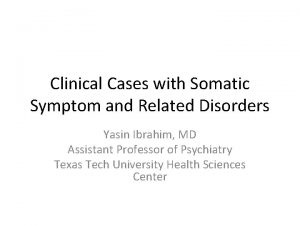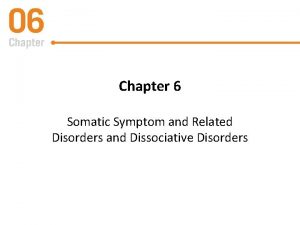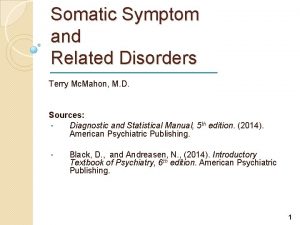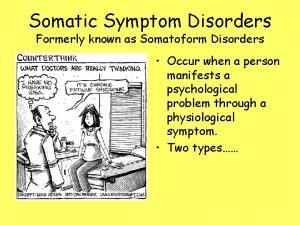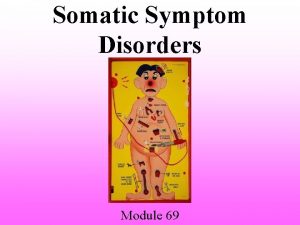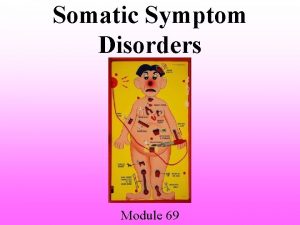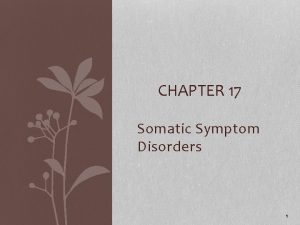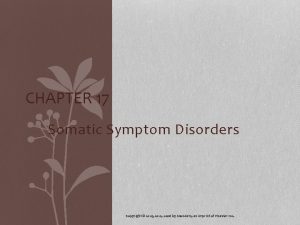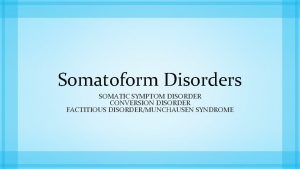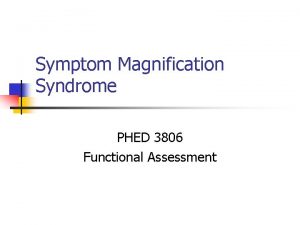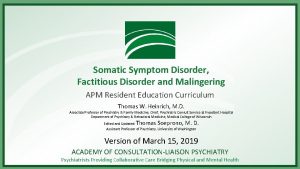Somatic Symptom Related Disorders Somatic Symptom Related Disorders

























- Slides: 25

Somatic Symptom & Related Disorders.

Somatic Symptom & Related Disorders. 1. Somatic Symptom Disorder 2. Illness Anxiety Disorder 3. Conversion Disorder 4. Psychological factors affecting other medical conditions 5. Factitious disorder

Somatic Symptom Disorder Diagnostic Criteria A. One or more somatic symptoms that are distressing or result in significant disruption of daily life. B. Excessive thoughts, feelings, or behaviors related to the somatic symptoms or associated health concerns as manifested by at least one of the following: 1. Disproportionate and persistent thoughts about the seriousness of one’s symptoms. 2. Persistently high level of anxiety about health or symptoms. 3. Excessive time and energy devoted to these symptoms or health concerns.

Somatic Symptom Disorder Diagnostic Criteria C. Although any one somatic symptom may not be continuously present, the state of being symptomatic is persistent (typically more than 6 months). Specify current severity: • Mild: Only one of the symptoms specified in Criterion B is fulfilled. • Moderate: Two or more of the symptoms specified in Criterion B are fulfilled. • Severe: Two or more of the symptoms specified in Criterion B are fulfilled, plus there are multiple somatic complaints (or one very severe somatic symptom).

Illness Anxiety Disorder A. Preoccupation with having or acquiring a serious illness. B. Somatic symptoms are not present or, if present, are only mild in intensity. If another medical condition is present or there is a high risk for developing a medical condition (e. g. , strong family history is present), the preoccupation is clearly excessive or disproportionate. C. There is a high level of anxiety about health, and the individual is easily alarmed about personal health status.

Illness Anxiety Disorder D. The individual performs excessive health-related behaviors (e. g. , repeatedly checks his or her body for signs of illness) or exhibits maladaptive avoidance (e. g. , avoids doctor appointments and hospitals). E. Illness preoccupation has been present for at least 6 months, but the specific illness that is feared may change over that period of time. F. The illness-related preoccupation is not better explained by another mental disorder.

Illness Anxiety Disorder • Specify whether: • Care-seeking type: Medical care, including physician visits or undergoing tests and procedures, is frequently used. • Care-avoidant type: Medical care is rarely used.

Conversion Disorder (Functional Neurological Symptom Disorder) A. One or more symptoms of altered voluntary motor or sensory function. B. Clinical findings provide evidence of incompatibility between the symptom and recognized neurological or medical conditions. C. The symptom or deficit is not better explained by another medical or mental disorder. D. The symptom or deficit causes clinically significant distress or impairment in social, occupational, or other important areas of functioning or warrants medical evaluation.

Conversion Disorder • Examples of such examination findings include • Hoover's sign, in which weakness of hip extension returns to normal strength with contralateral hip flexion against resistance. • Marked weakness of ankle plantar-flexion when tested on the bed in an individual who is able to walk on tiptoes. • Positive findings on the tremor entrainment test. • In attacks resembling epilepsy or syncope ("psychogenic" non-epileptic attacks), the occurrence of closed eyes with resistance to opening or a normal simultaneous electroencephalogram • For visual symptoms, a tubular visual field (i. e. , tunnel vision).

Psychological Factors Affecting Other Medical Conditions A. A medical symptom or condition (other than a mental disorder) is present. B. Psychological or behavioral factors adversely affect the medical condition in one of the following ways: 1. The factors have influenced the course of the medical condition as shown by a close temporal association between the psychological factors and the development or exacerbation of, or delayed recovery from, the medical condition. 2. The factors interfere with the treatment of the medical condition (e. g. , poor adherence).

Psychological Factors Affecting Other Medical Conditions 3. The factors constitute additional well-established health risks for the individual. 4. The factors influence the underlying pathophysiology, precipitating or exacerbating symptoms or necessitating medical attention. C. The psychological and behavioral factors in Criterion B are not better explained by another mental disorder

Psychological Factors Affecting Other Medical Conditions • Specify current severity: • Mild: Increases medical risk (e. g. , inconsistent adherence with anti-hypertension treatment). • Moderate: Aggravates underlying medical condition (e. g. , anxiety aggravating asthma). • Severe: Results in medical hospitalization or emergency room visit. • Extreme: Results in severe, life-threatening risk (e. g. , ignoring heart attack symptoms).

Factitious Disorder Imposed on Self A. Falsification of physical or psychological signs or symptoms, or induction of injury or disease, associated with identified deception. B. The individual presents himself or herself to others as ill, impaired, or injured. C. The deceptive behavior is evident even in the absence of obvious external rewards.

Factitious Disorder D. The behavior is not better explained by another mental disorder, such as delusional disorder or another psychotic disorder. Specify: • Single episode • Recurrent episodes (two or more events of falsification of illness and/or induction of injury)

Factitious Disorder Imposed on Another (Previously Factitious Disorder by Proxy) A. Falsification of physical or psychological signs or symptoms, or induction of injury or disease, in another, associated with identified deception. B. The individual presents another individual (victim) to others as ill, impaired, or injured. C. The deceptive behavior is evident even in the absence of obvious external rewards. D. The behavior is not better explained by another mental disorder

Factitious Disorder Note: The perpetrator, not the victim, receives this diagnosis. Specify. • Single episode • Recurrent episodes (two or more events of falsification of illness and/or induction of

Dissociative Disorders

• Dissociative Disorder are characterized by a disruption of and/or discontinuity in the normal integration of consciousness, memory, identity, emotion, perception, body representation, motor control, and behavior. Dissociative symptoms can potentially disrupt every area of psychological functioning. • This Include: 1. Dissociative Identity Disorder 2. Dissociative Amnesia, 3. Depersonalization/Derealization Disorder

Dissociative Identity Disorder A. Disruption of identity characterized by two or more distinct personality states, which may be described in some cultures as an experience of possession. The disruption in identity involves marked discontinuity in sense of self and sense of agency, accompanied by related alterations in affect, behavior, consciousness, memory, perception, cognition, and/or sensory-motor functioning. These signs and symptoms may be observed by others or reported by the individual.

Dissociative Identity Disorder B. Recurrent gaps in the recall of everyday events, important personal information, and/ or traumatic events that are inconsistent with ordinary forgetting. C. The symptoms cause clinically significant distress or impairment in social, occupational, or other important areas of functioning. D. The disturbance is not a normal part of a broadly accepted cultural or religious practice.

Dissociative Identity Disorder Note: In children, the symptoms are not better explained by imaginary playmates or other fantasy play. E. The symptoms are not attributable to the physiological effects of a substance (e. g. , blackouts or chaotic behavior during alcohol intoxication) or another medical condition (e. g. , complex partial seizures).

Dissociative Amnesia A. An inability to recall important autobiographical information, usually of a traumatic or stressful nature, that is inconsistent with ordinary forgetting. Note: Dissociative amnesia most often consists of localized or selective amnesia for a specific event or events; or generalized amnesia for identity and life history. B. The symptoms cause clinically significant distress or impairment in social, occupational, or other important areas of functioning.

Dissociative Amnesia C. The disturbance is not attributable to the physiological effects of a substance or a neurological or other medical condition D. The disturbance is not better explained by other mental disorders.

Depersonalization/Derealization Disorder A. The presence of persistent or recurrent experiences of depersonalization, Derealization, or both: 1. Depersonalization: Experiences of unreality, detachment, or being an outside observer with respect to one’s thoughts, feelings, sensations, body, or actions (e. g. , perceptual alterations, distorted sense of time, unreal or absent self, emotional and/ or physical numbing). 2. Derealization: Experiences of unreality or detachment with respect to surroundings (e. g. , individuals or objects are experienced as unreal, dreamlike, foggy, lifeless, or visually distorted).

Depersonalization/Derealization Disorder B. During the depersonalization or derealization experiences, reality testing remains intact. C. The symptoms cause clinically significant distress or impairment in social, occupational, or other important areas of functioning. D. The disturbance is not attributable to the physiological effects of a substance or another medical condition E. The disturbance is not better explained by another mental disorder,
 Cengage
Cengage Somatic symptom disorder
Somatic symptom disorder Chapter 17 somatic symptom disorders
Chapter 17 somatic symptom disorders Nursing care plan for somatoform disorder
Nursing care plan for somatoform disorder Somatic symptom disorder
Somatic symptom disorder Somatic symptom
Somatic symptom Somatic symptom disorder vs factitious disorder
Somatic symptom disorder vs factitious disorder Work related musculoskeletal disorders definition
Work related musculoskeletal disorders definition Bipolar and other related disorders
Bipolar and other related disorders Neurotic, stress-related and somatoform disorders
Neurotic, stress-related and somatoform disorders Neurotic stress-related and somatoform disorders
Neurotic stress-related and somatoform disorders Bipolar and other related disorders
Bipolar and other related disorders The integration of eye, hand, and foot movements
The integration of eye, hand, and foot movements Fitness related images
Fitness related images Tscc score sheet
Tscc score sheet Kommunicerande hydrocefalus
Kommunicerande hydrocefalus Mikael riska
Mikael riska Esas skala
Esas skala Sas assessment tool
Sas assessment tool Gastroparesis cardinal symptom index calculator
Gastroparesis cardinal symptom index calculator Skytteglasögon ansi/mil-spec
Skytteglasögon ansi/mil-spec Pms symptoms
Pms symptoms Trauma symptoms inventory
Trauma symptoms inventory Pqrst symptom analysis
Pqrst symptom analysis Sekundr
Sekundr Trauma symptom checklist for children™ screening form
Trauma symptom checklist for children™ screening form
